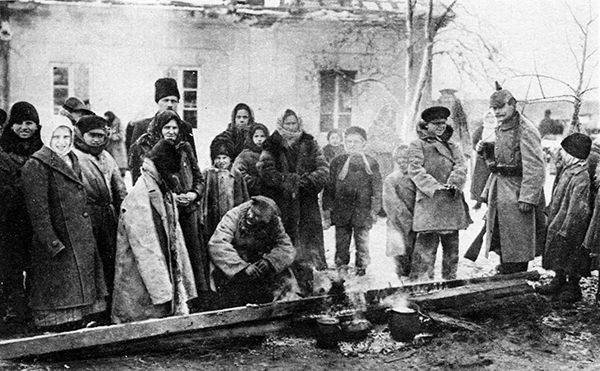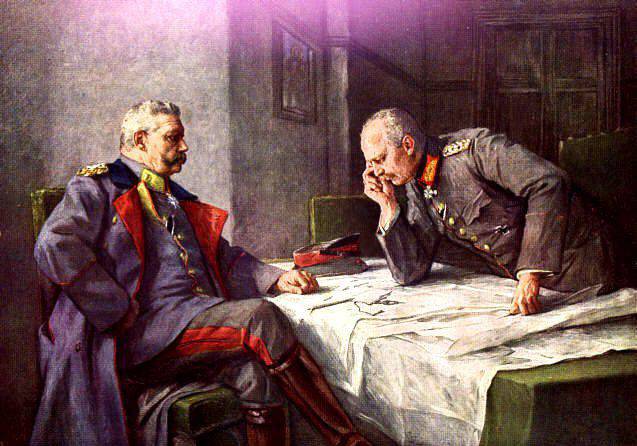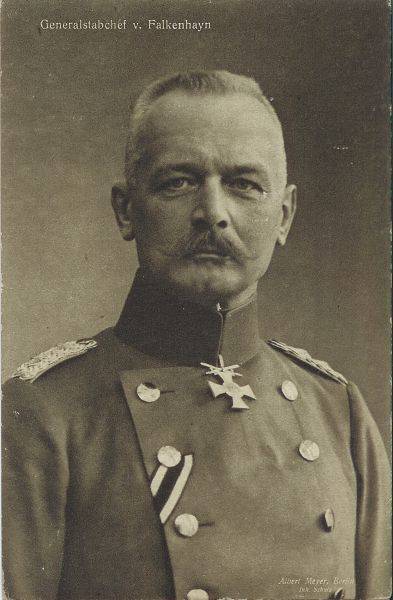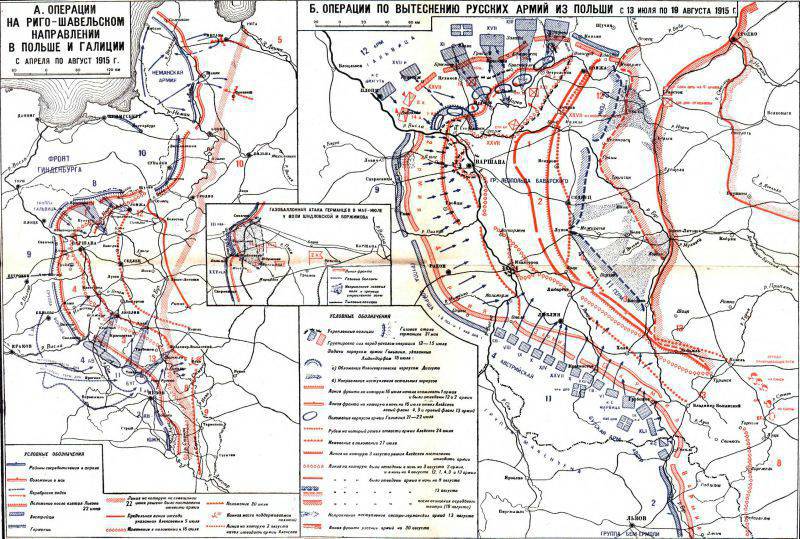The great retreat of the Russian army
In addition, the Great Retreat became a strong destabilizing factor: the authorities, wishing to cause a popular upturn following the example of 1812 of the year, initiated a mass exodus from the left territories, which led to a sharp increase in social tensions in the empire. Millions of destitute, sick, often illiterate refugees, who do not understand, like most other subjects of the empire, why Russia is at war, the causes of their problems, have seriously strengthened the social base of revolutionaries.

Russian refugees
"Polish bag"
Even during the military meeting at Plyos Castle with the participation of the Kaiser and the High Command of Germany and Austria-Hungary, the Eastern command of the Germans demanded that pressure continue in the East. Ludendorff and Hindenburg voiced a grand plan for the encirclement of Russians between Kovno and Grodno. Ludendorff demanded a new large reinforcement, which will allow to launch a large offensive along the Baltic coast and decide the outcome of the war in favor of the Central Powers. At the end of June, Ludendorff again tried to push through the idea of encircling the Russian troops, offering to strike at the south and, closing the ring at Brest-Litovsk and the Pripyat swamps, to destroy all the main military units of the Russian army.
The German commanders, after the capture of Lviv’s 22 in June, decided what to do next: to move further east, to Volyn, or to turn the operating direction abruptly to the north. The first decision led to the fact that the German troops were permanently tied up on the Russian front, and in Berlin they were considered secondary. The head of the General Staff of Germany, General Erich von Falkenhayn, in principle, was extremely wary of the idea of a strategic offensive deep into the Russian Empire. He was always internally skeptical about the victories in the Russian theater of war: they decided very little, Russia was huge and Russian troops could retreat deep into the territory: “Russians can retreat to the great depth of their country and we cannot pursue them endlessly”.
Therefore, Falkenhayn decided on another solution. In early July, 1915, he decided to conduct an operation with a limited goal - to make an attempt to arrange "Cannes" for the Russian troops stationed in Poland between pp. Wisla and Bug. For this, a shock group of 3 armies was formed. The Mackensen 11 Army and the Austrian 4 Army were reinforced by several German and Austrian divisions and aimed to move in a northerly direction. At the same time, out of the expanded 11 army, an independent group was set up on its right wing, which formed the Bug army of General Linsingen. To ensure the right wing of the Bug army, the 1-I Austrian army was transferred to the Sokal region from the Upper Vistula, and on the left bank of the r. Wisla remained only army group Voirsh. To hide the preparation of a strike to the north, the Southern Army and the 2-I Austrian army had to conduct an auxiliary operation.
Toward the group Mackensen, from Prussia, was to attack the 12-I army of Ghlvitsa. Three armies were to converge at Warsaw and ring the entourage of the 4 Russian armies in Poland (1, 2, 4, and 3). However, with such a statement of the main idea of the operation between Falkenhain and the Eastern command, a sharp disagreement appeared. Under the command of Hindenburg there were the following armies: the newly formed Neman army under the command of General Scholz, which operated through northern Lithuania against Kurland; 10-I army of General Eichhorn on Middle Neman; 8-I army of General von Belov - between pp. Lyk and Shkva; Army Group General Galvitsa - from p. Shkva to the right bank of the river. Wisla (reorganized into the 12 army); 9-I army of Leopold of Bavaria - on the left bank of the r. Wisla (below Novogeorgievsk) and to r. Pilica
Falkenhain’s proposal to support the Mackensen strike group with a decisive attack from the Nizhny Narew site or from the Vistula, Hindenburg and Ludendorf sections was opposed. They had a bridgehead in the Baltic States and wanted to use it, believing that only on the north wing of the Hindenburg front, in the Nemansky army area, while attacking Kovno, it was possible to introduce decisive forces to achieve decisive success. With this development, the Mackensen army group was supposed to strike north from Lviv, bypassing east of Warsaw, and the Hindenburg troops would break through not to Warsaw, but to Vilna and Minsk, to encircle the Russian armies 4. The detour turned out to be deeper, it was harder for Russian troops to escape. The chief of staff of the German Eastern Front, General Erich von Ludendorff, was confident that the Russian troops, relying on their fortresses in Novogeorgievsk, Kovno, Grodno, Osovets and Brest, would try to keep their “Polish protrusion” as long as possible, which in the end would allow the German army to make strategic environment of all Russian armies in Poland. The military-political catastrophe of Russia in such a scenario would be obvious, it had to surrender to the mercy of the winners.

Paul von Hindenburg (left) and Erich Ludendorff (right) at headquarters

Erich von Falkenhayn
However, the chief of the German General Staff Falkenhayn considered the plan of the Eastern command an adventure. For such an operation, the German army simply would not have enough strength. He believed that it was better to set goals more modest, but rather. The Chief of the General Staff noted that the coverage of the Hindenburg front with the left wing would lead, at best, only to the local tactical success of the 10 or Neman army, and not the defeat of the Russian troops in Poland.
2 July in Poznan held a military meeting. Kaiser Wilhelm II listened to both sides and supported Falkenhayn. The Hindenburg Plan was rejected. He received a directive to send troops to Galvitsa to break through the 12 in July of the Russian positions in the Lower Narev on both sides of Prasnysh, in order to cut off the Russian troops that were at the Vistula and in front of the Mackensen group. The right wing of the 8 Army Belov was supposed to join the attack of Galvitsa, attacking between pp. Shkva and Pissa in the direction of Lomza. The troops of Mackensen and Galvitsa were to unite in the Sedlec area. But the Eastern Command fulfilled the directive only partially. The onset of Galvitsa began to prepare, in addition, they decided to strike from the Baltic states. Since the political weight of Hindenburg, “the savior of East Prussia from the wild Russians,” was enormous, his plan was not canceled.
Thus, the Hindenburg troops inflicted two main blows: the Galvitsa group on Pultusk-Sedlec against the Mackensen armies and the Eichhorn 10 army - on Kovno-Vilna-Minsk. This sprayed the forces of the northern “claws” of the German army and eventually became one of the prerequisites for the failure of the German command, since it was not possible to create the “Polish bag”. “The enemy scattered his efforts,” noted the military historian A. Kersnovsky, “the Russian armies received two heavy blows, but it was better than getting one deadly.”
Source: Zayonchkovsky A. M. World War 1914-1918
Plans for the Russian command. State of the army
At the meeting of the Russian command in the Hill 17 June all attention was focused on Galicia. It was believed that in the North will not be anything serious. Alekseev had enough strength to repel the enemy offensive. The commander of the North-Western Front had 7 armies (10-I, 12-I, 1-I, 2-I, 5-I, 4-I and 3-I), 43 infantry and 13 cavalry divisions (total 116 divisions (from the total 35 divisions), and XNUMX cavalry divisions on the entire Eastern Front). True, the idea of abandoning Russian Poland was voiced. It was proposed to leave the "Polish protrusion", reduce the front line and strengthen the defense. However, political considerations turned out to be higher: the abandonment of Poland, especially after the loss of Galicia, dealt a blow to Russia's foreign policy prestige.
In addition, they did not want to leave the fortress, which was spent a lot of money and resources. Powerful fortresses — Ivan-Gorod, Novogeorgievsk, Kovno, Grodno, Osovets, Brest — built in the previous epoch, although they lost some of their previous value, they were still strong strongholds, especially with the support of field troops. Ivan-Gorod and Osovets in the spring-summer of 1915, played a positive role. However, the development of military equipment and methods of assault dramatically reduced their importance. As the 1914 campaign of the year on the Western Front showed, the Germans easily smashed the Belgian and French strongholds. It was difficult for the Russians to bring the siege weapons to the Austrian Przemyshl, and its siege dragged on. The Germans had no such problems. As a result, the fortress ceased to be impregnable, forced to keep in them large garrisons, which doomed to surrender and shackled a large number of artillery and shells, which were so needed by field troops. For example, in the great fortress Novogeorgievsk, which was considered the key to Warsaw, there were 1680 cannons with a million shells. And in all the fortresses there were 5200 old guns and 3148 new guns plus 880 heavy guns.
For the Russian High Command, the main task was clear: to preserve the heavily damaged army until the autumn thaw, which would leave the activity of the Austro-German troops and allow the full combat capability of the armies to be restored, to strengthen the defense. At the meeting of June 24, it was decided to gradually withdraw Russian troops to the Riga-Middle Neman line with the fortresses of Kovno and Grodno-r. Svisloch - Upper Narew - Brest-Litovsk - Upper Bug Current - p. Dniester and to Romania. The problem was that the enemy was not going to wait, and the bulk of the Russian troops stationed west of the line in the so-called. "Polish bag".
The combat capability of the Russian army in this period has already significantly decreased. According to the states in the Russian corps there should have been 1,5 million soldiers, in fact, there were barely about 1 million bayonets and sabers. Incomplete reached half a million people. In this case, the arriving replenishments often did not have rifles, turning into ballast, only chilling the combat-ready core of the parts. The quality of replenishments plummeted. So recruits due to lack of rifles were not trained in shooting. Not enough officers. The collapse of the former army structure, which preserved the unity of the empire, began. The pre-war personnel officer corps was largely knocked out. Officer schools let out 35 thousands of officers a year, but they were not enough. At 3, thousands of soldiers now accounted for 10-15 officers, and their experience and qualifications plummeted. Representatives of the intelligentsia and the semi-intellectuals, which were often dominated by opposition sentiments, went to the officers. Sharply increased the gap between the officer caste and privates. The captain of the Russian army celebrated in the autumn of 1915: "The officers lost faith in their people." Not being able to raise the cultural level of the soldier, part of the officers sharply hardened, not stopping in front of the most severe punishments. This made the masses of the soldiers (peasant in essence) even more angry. For comparison, it is worth remembering that the Germans recruited more than 80% of the army from the townspeople, from skilled workers, educated and disciplined. That is, in this respect, the quality of the German army was much higher.
The military-material part of the Russian army was either lost during a lengthy retreat from Galicia, or was heavily worn out. A huge shortage was felt in the ammunition. So, in the mobile stocks of the armies of the South-Western Front there were no more than 40% of the established combat kits. Defeat, retreat and heavy losses led to a serious drop in the fighting spirit of the soldiers. Particularly strongly decomposition began to be felt in the rear. The recruits did not want to die, they were afraid to go to the front. The command even decided to build military barracks in small towns - the units stationed in large industrial centers quickly decomposed. In the advanced, shelled parts the spirit was still preserved.
The beginning of the German offensive. Mackensen’s Kick
Mackensen’s grouping began to turn north. 26 June 1915, the commander of the southern grouping of the Austro-German armies, August von Mackensen, launched an offensive against the Russian positions on the section of the Tanev-Rawa-Russkaya river. The German command began to implement the first part of the plan for the encirclement of Russian troops in Poland.
The Germans attacked the 3 Army, which had suffered a lot in the previous battles. The main blow Mackensen sent to the left flank of the Russian army in the area of responsibility of the Russian 24 corps. The Germans had a serious advantage in the area of the 3 Army: 10 Russian heavily drained divisions, totaling 40 thousand, had to stop the onslaught of 8 German divisions, numbering more than 60 thousand soldiers. The predominance of German artillery was complete. The enemy was counting on the move to crush the Russian army. However, General Leonid Lesh skillfully organized the defense on the Tanev River and maneuvered well with the available forces. Therefore, on the move to break through the Russian defense of the Germans did not work. Tomashov began heavy fighting.
Front commander Alekseev quickly responded and sent 31 Army Corps and other units from the front reserve. The group of General Olohova managed to effectively counterattack Mackensen’s advancing units, struck at his right flank. In the four-day stubborn battle the Germans were rejected. The Olohovo group was transformed into the 13 Army and consolidated the defense of the front.
The German command was forced to suspend the offensive and regroup its forces. 4 July 1915, the Mackensen grouping again went on the offensive. Now the Germans tried to break through the defenses of the 3 army on the right flank, at the junction of the 3 and 4 armies, in the area of Krasnik. Our troops had a very hard time. Russian artillery was generally silent, no shells. German artillerymen became impudent to such an extent that they went to open positions and fired from 1-2 km. Lesh responded by ordering the creation of mobile machine-gun groups in the regiments, pushing them to a dangerous area and shooting German batteries.
Austro-German troops suffered heavy losses and were driven back. In the four-day battle of Tanev (from 4 to 7 in July), the enemy was defeated. Austro-Hungarian troops suffered especially heavy losses. Russian troops captured more than 20 thousand people. It was a great success, especially against the background of previous defeats from the "Mackensen phalanx" and the acute shortage of ammunition.
The Russian command at this time undertook modern measures. From the reserve Bets on the dangerous area transferred the 2 and 6 of the Siberian corps and the Guards corps. The 3 Army was seriously reinforced. As a result, the German command lost hope for a quick breakthrough. In addition, on the South-Western Front, the 11-I Russian army launched a counterattack near the town of Zhuravno on the Dniester. The southern army was defeated. The Austro-German command was forced to stop the offensive and began to tighten additional troops.
To be continued ...

Information